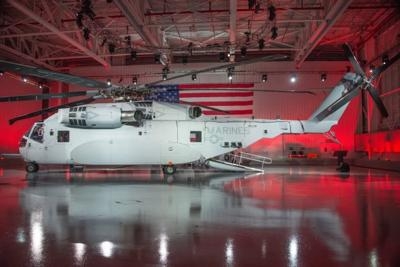USMC Reveals Aircraft Name
The CH-53K heavy lift helicopter, the next generation in the CH-53 type series that the U.S. Marine Corps expects to begin operational service in 2019, has been officially unveiled by Sikorsky. During the rollout ceremony, attended by members of Congress, the Department of Defense, major suppliers to the program, international guests and company employees, the Commandant of the Marine Corps General F. Amos introduced the name for the new aircraft: the “King Stallion.”

“The rollout of the CH-53K helicopter introduces a new era in Marine Corps aviation and is an exciting milestone in our company’s 91 year history,” said Sikorsky President Mick Maurer. “The CH-53K aircraft will effectively triple the external load carrying capacity of the CH-53E aircraft — to more than 27,000 pounds over a mission radius of 110 nautical miles. With its 88,000-pound maximum gross weight, powerful new engines, lightweight composite structure, new rotor blades and fly-by-wire flight controls, the CH-53K will have the means to move troops and equipment from ship to shore, and to higher altitude terrain, more quickly and effectively than ever before.”
GE Aviation’s all-new T408 engine plays a key role in the increased capability of the CH-53K helicopter. Compared to the CH-53E aircraft’s T64 turboshaft powerplant, the three new engines provide 57 percent more power for approximately 20 percent lower specific fuel consumption. To convert the extra engine power into torque and shaft horsepower within a similarly-sized main gearbox, Sikorsky developed a new transmission that efficiently transfers the engine power to the CH-53K helicopter’s main rotors.
For increased lift, Sikorsky developed the largest and most technologically advanced main rotor blade the company has ever produced. At 35 feet span length, and almost three feet chord width, the all-composite blade has 12 percent more surface area than the CH-53E blade. The new aircraft’s major airframe sections were built from strong, lightweight advanced composite materials by Aurora Flight Sciences, Exelis, GKN Aerospace and Spirit Aerosystems. A Rockwell Collins digital glass cockpit governs a fly-by-wire flight control system developed by Sikorsky, UTC Aerospace Systems, Eaton and BAE.
The CH-53K is one of the first all-digitally designed helicopters. This approach enabled Sikorsky to assemble the aircraft inside a 3D virtual reality lab at its Stratford, Connecticut, headquarters before prototype production began. “Our ‘build before you build’ approach allowed our engineers to work ‘inside’ the helicopter,” said Maurer, “to verify assembly designs and correct issues long before discovery and expensive rework on the assembly line.”
Sikorsky and the government are applying methodology that will enable the Marine Corps to analyze flight, maintenance and performance data from every aircraft. By identifying trends across the fleet, the Marines are expected to realize significant improvements in aircraft readiness and reduced operational costs compared to the CH-53E fleet.
In April, Sikorsky began powered ground tests of the CH-53K aircraft systems, such as rotors, drive, electrical, hydraulic, avionics and flight controls. Hundreds of hours of powered ground tests will prepare the CH-53K team for first flight at the end of 2014, and the start of a three-year flight test program.
Per the current program of record, the Marine Corps intends to order 200 CH-53K production aircraft and stand up eight operational squadrons and one training squadron to support the Marine Corps’ operational requirements. Eventual production quantities would be determined year-by-year over the life of the program based on funding allocations set by Congress and the U.S. Department of Defense acquisition priorities.
(Image provided by Sikorsky)
 ANNouncement: Now Accepting Applications For Oshkosh 2024 Stringers!!!
ANNouncement: Now Accepting Applications For Oshkosh 2024 Stringers!!! Aero-News: Quote of the Day (06.13.24)
Aero-News: Quote of the Day (06.13.24) ANN's Daily Aero-Term (06.13.24): Dead Reckoning
ANN's Daily Aero-Term (06.13.24): Dead Reckoning ANN's Daily Aero-Linx (06.13.24)
ANN's Daily Aero-Linx (06.13.24) ANN FAQ: How Do I Become A News Spy?
ANN FAQ: How Do I Become A News Spy?



